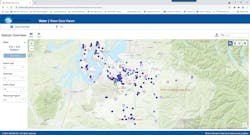Intro
Washington stormwater utility recognized constraints of outdated database to store growing amount of data and differing data formats. Aging IT infrastructure was limiting value from watershed data and accessibility. A modern database now harmonizes data types such as GIS and time-series, continuous and discrete, enabling deeper data analysis and inviting data exploration by residents.
Problem
Pierce County's Planning & Public Works Department needed to upgrade IT systems to better monitor the water supply and enhance public outreach as the population has grown rapidly.
With Seattle and King County’s economic boom, adjacent Pierce and Snohomish counties have experienced population gains. Development poses challenges to maintaining and improving water quality.
The most common concerns are high levels of bacteria and nutrients (nitrogen and phosphorus, specifically), elevated summer temperatures, and low dissolved oxygen levels in streams and waterbodies.
Dedicated staff didn’t want to compromise quality of life as the community grew. They recognized they were collecting a significant amount of data, but the full value from the information wasn’t readily accessible.
Legacy databases of long-term hydrologic and water quality data lacked automation to aggregate data from multiple sources, affirm data quality, or ease data access to its stakeholders. Once effective servers and custom-built databases were no longer supported.
The department was still responsible with reducing flood risk and preventing stormwater runoff from polluting the water supply. With strategic foresight, it sought a new data system that would be compatible with evolving technologies as well as help maintain public safety, meet regulatory requirements and enhance public outreach.
Solution
The county's new water software, integrated with existing GIS tools, empower staff to better monitor the overall water supply and meet future data needs without further investment.
Staff now have a reliable water data management tool in Water Information System KISTERS (WISKI). Flexible architecture is designed to grow with the agency's needs in terms of data volume and technological innovation without incurring additional development costs.
Automation and analytical functions within the software enable maximum efficiency. Continuous and discrete datasets are no longer maintained in separate systems; a single repository that also manages metadata ensures more discoverability and more comprehensive analysis by analysts and planners.
As more water quality data are collected, automated quality checks and an audit trail provide transparency and greater confidence in the information for decisions and policies. From raw data import to data validation, automated or manual, all data processing is fully documented.
APIs enable multi-department data consumers to use GIS as well as python scripts to analyze data and interpret information without learning unfamiliar software or code.
Results
Integration of hydrological, water quality sampling and bioassessment datasets increase data usability and deeper analysis.
Time-savings and higher level of data quality result from standardized application of data quality assurance and quality control procedures.
Public engagement and Water Quality Index education are enriched by the addition of an interactive web portal, which invites visitors to filter, view graphs, and export agency-approved data.
Staff scientists and modelers who inform decisions now face fewer time and data loss. Instead, they focus on monitoring and investigation surface and groundwater interactions.
Neighboring stormwater utility Snohomish County Surface Water Management (SWM) also uses WISKI, so peers are able to discuss regional challenges and share best software practices.


